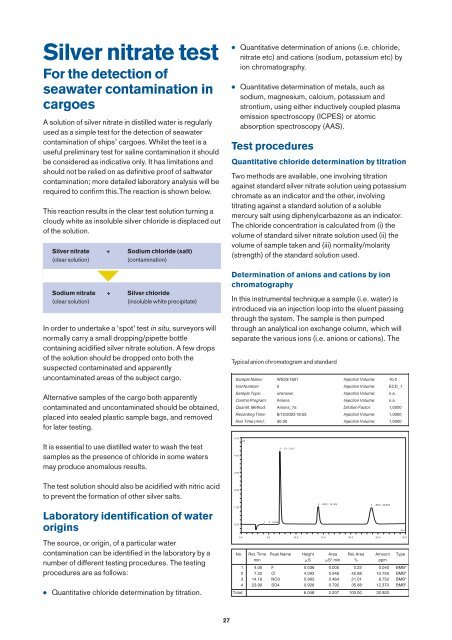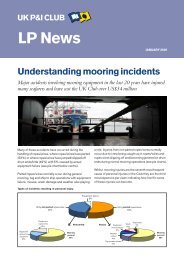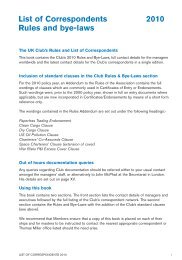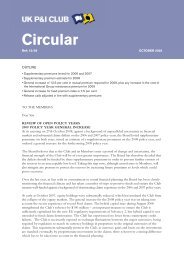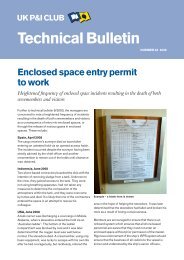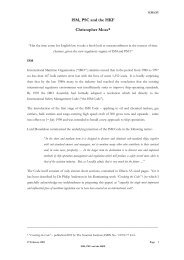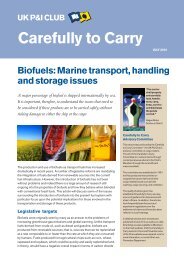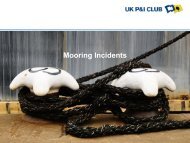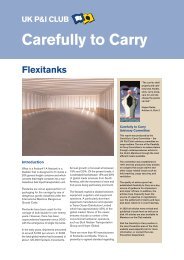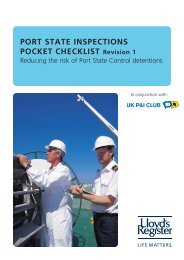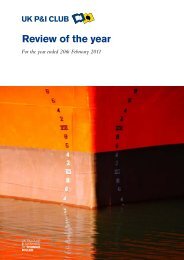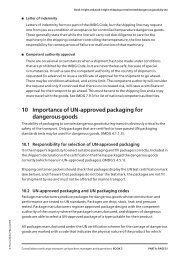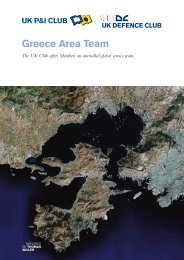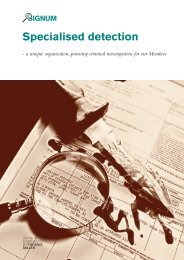Bulk Matters - UK P&I
Bulk Matters - UK P&I
Bulk Matters - UK P&I
Create successful ePaper yourself
Turn your PDF publications into a flip-book with our unique Google optimized e-Paper software.
Silver nitrate test<br />
For the detection of<br />
seawater contamination in<br />
cargoes<br />
A solution of silver nitrate in distilled water is regularly<br />
used as a simple test for the detection of seawater<br />
contamination of ships’ cargoes. Whilst the test is a<br />
useful preliminary test for saline contamination it should<br />
be considered as indicative only. It has limitations and<br />
should not be relied on as definitive proof of saltwater<br />
contamination; more detailed laboratory analysis will be<br />
required to confirm this.The reaction is shown below.<br />
This reaction results in the clear test solution turning a<br />
cloudy white as insoluble silver chloride is displaced out<br />
of the solution.<br />
Silver nitrate + Sodium chloride (salt)<br />
(clear solution)<br />
(contamination)<br />
Sodium nitrate + Silver chloride<br />
(clear solution)<br />
(insoluble white precipitate)<br />
In order to undertake a ‘spot’ test in situ, surveyors will<br />
normally carry a small dropping/pipette bottle<br />
containing acidified silver nitrate solution. A few drops<br />
of the solution should be dropped onto both the<br />
suspected contaminated and apparently<br />
uncontaminated areas of the subject cargo.<br />
Alternative samples of the cargo both apparently<br />
contaminated and uncontaminated should be obtained,<br />
placed into sealed plastic sample bags, and removed<br />
for later testing.<br />
●<br />
●<br />
Quantitative determination of anions (i.e. chloride,<br />
nitrate etc) and cations (sodium, potassium etc) by<br />
ion chromatography.<br />
Quantitative determination of metals, such as<br />
sodium, magnesium, calcium, potassium and<br />
strontium, using either inductively coupled plasma<br />
emission spectroscopy (ICPES) or atomic<br />
absorption spectroscopy (AAS).<br />
Test procedures<br />
Quantitative chloride determination by titration<br />
Two methods are available, one involving titration<br />
against standard silver nitrate solution using potassium<br />
chromate as an indicator and the other, involving<br />
titrating against a standard solution of a soluble<br />
mercury salt using diphenylcarbazone as an indicator.<br />
The chloride concentration is calculated from (i) the<br />
volume of standard silver nitrate solution used (ii) the<br />
volume of sample taken and (iii) normality/molarity<br />
(strength) of the standard solution used.<br />
Determination of anions and cations by ion<br />
chromatography<br />
In this instrumental technique a sample (i.e. water) is<br />
introduced via an injection loop into the eluent passing<br />
through the system. The sample is then pumped<br />
through an analytical ion exchange column, which will<br />
separate the various ions (i.e. anions or cations). The<br />
Typical anion chromatogram and standard<br />
Sample Name: WS03/1601 Injection Volume: 10.0<br />
Vial Number: 5 Injection Volume: ECD_1<br />
Sample Type: unknown Injection Volume: n.a.<br />
Control Program: Anions Injection Volume: n.a.<br />
Quantif. Method: Anions_7a Dilution Factor: 1,0000<br />
Recording Time: 8/12/2003 18:55 Injection Volume: 1,0000<br />
Run Time (min): 30.00 Injection Volume: 1,0000<br />
It is essential to use distilled water to wash the test<br />
samples as the presence of chloride in some waters<br />
may produce anomalous results.<br />
The test solution should also be acidified with nitric acid<br />
to prevent the formation of other silver salts.<br />
5.00<br />
S<br />
4.00<br />
3.00<br />
2.00<br />
2 - Cl - 7.217<br />
Laboratory identification of water<br />
origins<br />
The source, or origin, of a particular water<br />
contamination can be identified in the laboratory by a<br />
number of different testing procedures. The testing<br />
procedures are as follows:<br />
●<br />
Quantitative chloride determination by titration.<br />
1.00<br />
0.00<br />
1 - F - 4.053<br />
3 - NO3 - 14,163 4 - SO3 - 23.903<br />
0.0 5.0 10.0 15.0 20.0 25.0 30.0<br />
No. Ret. Time Peak Name Height Area Rel. Area Amount Type<br />
min S S* min % ppm<br />
1 4.05 F 0.036 0.005 0.22 0.040 BMB*<br />
2 7.22 Cl 4.093 0.946 42.88 10.759 BMB*<br />
3 14.16 NO3 0.993 0.464 21.01 9.752 BMB*<br />
4 23.90 SO4 0.926 0.792 35.88 12.370 BMB*<br />
Total: 6.048 2.207 100.00 32.920<br />
min<br />
27


